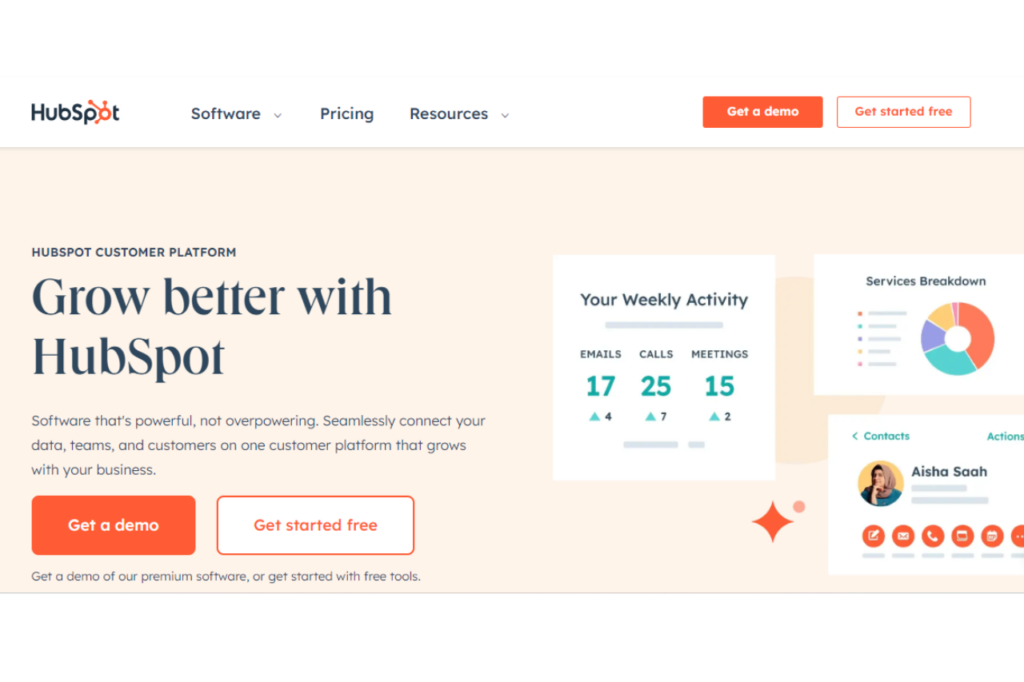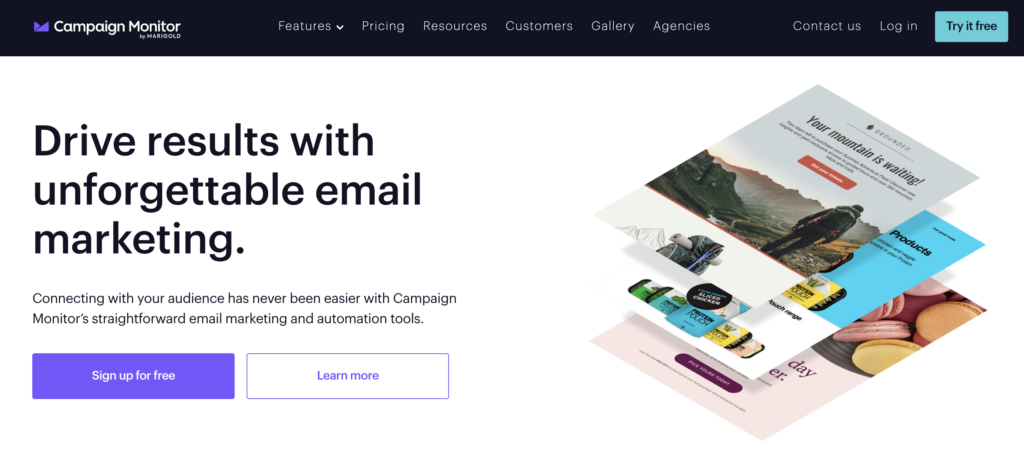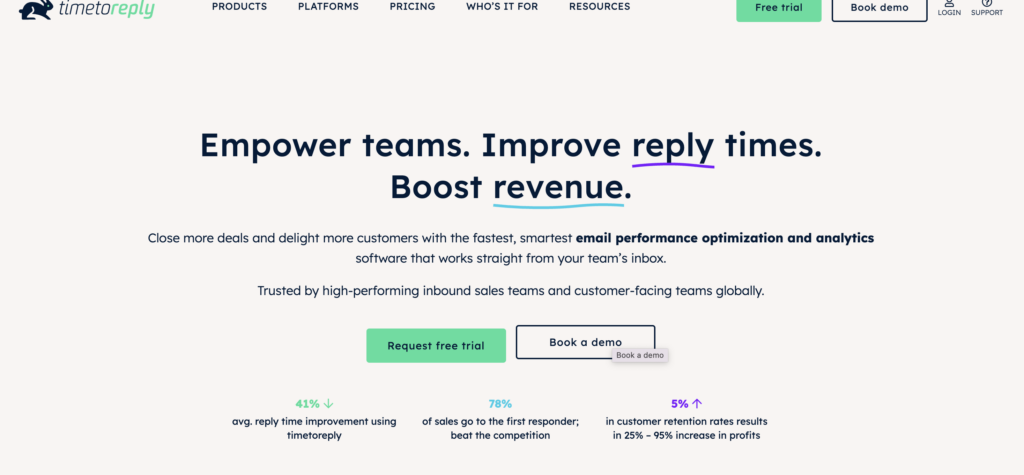Discover the top contenders in the dynamic world of email analytics with our roundup of the best email analytics platforms for customer-facing teams in 2024.
Stay ahead of the curve as we dive into the features that make these platforms the champions for optimizing your email strategies.
In 2024, the landscape of customer engagement is undergoing a revolutionary transformation, and at the heart of this evolution lies the indispensable tool of email analytics.
As businesses strive to connect meaningfully with their audience, the importance of leveraging the best email analytics platforms has never been more pronounced.
Join us on a journey into the pivotal role these platforms play in reshaping the strategies of customer-facing teams, unlocking unprecedented insights, and propelling engagement to new heights.
Before diving into the top email analytics platforms, let’s establish the criteria that define a high-quality email analytics platform.
Selecting the best email analytics platforms requires careful consideration of various criteria to ensure that the chosen solution aligns with your business’s specific needs and goals.
Here are key criteria to keep in mind when choosing the best email analytics platform for your business:
🔵 Ease of use:
The email analytics platform should be easy to use, with a simple and friendly interface that accommodates team members with different technical skills.
🔵 Data accuracy and reliability:
You want accurate and reliable data on email performance metrics, ensuring that the insights derived are trustworthy and actionable.
🔵 Comprehensive analytics:
Look for a platform that offers a comprehensive set of analytics metrics to provide a holistic view of your email campaigns and customer communications.
🔵 Compatibility with other tools:
Ensure that the email analytics platform seamlessly integrates with your existing email marketing tools, customer relationship management (CRM) systems, and other relevant software to streamline processes and enhance efficiency.
🔵 Tailored reporting:
The ability to customize reports and dashboards is crucial, allowing your team to focus on the specific metrics that matter most to your business objectives.
🔵 Security and compliance:
Prioritize platforms that adhere to industry data security and compliance standards, especially if your business operates in regulated industries such as healthcare or finance.
🔵 Growth capability:
Pick a platform that grows with your business, handling more data and changing analytics needs as you expand.
🔵 Automation and AI capabilities:
Platforms with automation capabilities and artificial intelligence (AI) integration can help automate routine tasks, optimize campaigns, and provide intelligent insights.
🔵 Customer support:
Evaluate the platform’s level of customer support, including the availability of documentation, training resources, and responsive customer service to address any issues or questions.
🔵 Cost and ROI:
Consider the platform’s overall cost in relation to its value. Assess the return on investment (ROI) potential by evaluating how well the platform aligns with your business objectives.
🔵 Real-time analytics:
Real-time analytics capabilities allow your team to respond promptly to changing trends and customer behavior, making it an essential criterion for dynamic marketing strategies.
By carefully evaluating these criteria, you can make an informed decision when selecting the best email analytics platform that meets your current needs and positions your business for future success.
Explore the market’s front-runners with our snapshot of leading email analytics platforms:
1️⃣ Google Analytics for Firebase:

Google Analytics for Firebase provides in-depth analytics for mobile apps, encompassing email campaigns. It offers user engagement metrics, conversion tracking, and user behavior analysis.
2️⃣ Mailchimp:

Mailchimp combines a user-friendly interface with a comprehensive email marketing platform and built-in analytics. It offers insights into open rates, click-through rates, and audience behavior.
3️⃣ HubSpot:

An all-in-one marketing platform with email analytics, HubSpot provides detailed reporting on email performance and customer engagement while offering personalized content creation.
4️⃣ Campaign Monitor:

Campaign Monitor is an email marketing and automation platform with analytics on campaign performance. It offers insights into subscriber engagement and behavior and a nifty drag-and-drop email builder.
5️⃣ timetoreply:

timeroreply specializes in email response time analytics. This platform provides detailed insights into how quickly emails are responded to, helping teams track and optimize communication efficiency. With an emphasis on response time metrics, real-time tracking, and reporting timetoreply is suitable for teams and businesses looking to enhance their email responsiveness.
Let’s dive into the distinctive features that make the best email analytics platforms stand out from the crowd.
Effective email analytics platforms should encompass a range of features to provide comprehensive insights into the performance of email campaigns.
Here’s a detailed analysis of must-have features in email analytics platforms:
🔘 Open rate tracking:
Importance: Measures the percentage of recipients who opened an email, indicating the initial engagement level.
Analysis: Allows assessment of subject line effectiveness and overall email visibility.
🔘 Click-through rate (CTR) analysis:
Importance: Evaluates the percentage of recipients who clicked on links within an email, indicating interest and engagement.
Analysis: Helps optimize content and identifies high-performing elements.
🔘 Conversion tracking:
Importance: Measures the number of recipients who took a desired action after clicking on an email link.
Analysis: Provides insights into the effectiveness of email campaigns in driving conversions and meeting goals.
🔘 Bounce rate monitoring:
Importance: Tracks the percentage of emails that were undeliverable, indicating potential issues with email lists or content.
Analysis: Helps maintain a clean and effective email list, improving deliverability.
🔘 List segmentation and analysis:
Importance: Enables segmentation based on user behavior, demographics, or engagement levels.
Analysis: Enhances personalization and targeting, leading to more relevant and effective campaigns.
🔘 A/B testing capabilities:
Importance: Allows testing different elements of an email (subject lines, content, visuals) to identify the most effective variations.
Analysis: Facilitates data-driven decision-making for optimizing future campaigns.
🔘 Response time tracking:
Importance: Measures the time it takes for individuals or teams to respond to emails.
Analysis: Enables assessment of communication efficiency and helps in setting and achieving response time goals.
🔘 Average response time metrics:
Importance: Calculates the average time it takes to respond to emails over a specific period.
Analysis: Provides a baseline for evaluating overall responsiveness and identifying areas for improvement.
🔘 Real-time response monitoring:
Importance: Offers insights into ongoing email response times in real-time.
Analysis: Allows teams to address urgent communication promptly and maintain a high level of responsiveness.
🔘 Team performance analytics:
Importance: Evaluates the response times of individual team members or departments.
Analysis: Facilitates performance tracking, identifies high-performing individuals, and offers insights for coaching or improvement.
🔘 Email volume and workload analysis:
Importance: Analyzes the volume of emails received and the workload of each team member.
Analysis: Provides insights into resource allocation, workload distribution, and potential bottlenecks.
🔘 Automated alerts and notifications:
Importance: Sends notifications or alerts for emails that require urgent responses.
Analysis: Enhances timely communication and ensures critical messages are addressed promptly.
🔘 Email tracking and performance trends:
Importance: Monitors trends in email response times over time.
Analysis: Offers historical insights to identify patterns, improvements, or challenges in responsiveness.
🔘 User-friendly interface:
Importance: Provides an intuitive and user-friendly interface for easy navigation.
Analysis: Enhances the usability of the platform, ensuring accessibility for all team members.
🔘 Scalability:
Importance: Accommodates the scalability needs of growing teams and evolving email volumes.
Analysis: Ensures the platform remains effective and responsive as the organization expands.
🔘 Automation and workflow analysis:
Importance: Automates routine tasks and analyzes the performance of automated workflows.
Analysis: Enhances efficiency, allowing teams to focus on strategic aspects of campaign management.
🔘 Integration with other tools:
Importance: Seamless integration with CRM systems, marketing automation tools, and other platforms.
Analysis: Streamlines workflows, centralizes data, and provides a holistic view of customer interactions.
🔘 Customizable dashboards and reports:
Importance: Allows users to tailor dashboards and reports to display key metrics relevant to their goals.
Analysis: Facilitates easy access to the most important information, improving decision-making.
🔘 Security and compliance features:
Importance: Ensures data security and compliance with regulations.
Analysis: Essential for businesses in regulated industries, instilling trust in users.
Incorporating these must-have features into an email analytics platform equips businesses with the tools needed to analyze, optimize, and enhance their email campaigns for better engagement and results.
Amidst the ever-shifting landscape of email analytics, businesses are looking for a toolkit of powerhouse features to effortlessly tackle their diverse needs and stay ahead of the game.
Open rate tracking and click-through rate (CTR) analysis serve as pivotal tools in measuring engagement, providing organizations with valuable insights into initial interaction and recipient engagement with their content. These features play a crucial role in evaluating subject line effectiveness and email visibility, assisting teams in refining their content strategies and identifying standout elements that captivate and retain audience engagement.
Now, let’s talk about response time tracking and average response time metrics – the champions of excellent customer service. These features allow businesses to clock how fast teams respond to emails, creating a culture of speedy replies. Afterall, delayed email responses significantly impact customer service, as studies indicate that 62% of customers expect replies within an hour.
And don’t forget team performance analytics, the feature that closely examines how individual team members or departments are rocking their response times and meeting those targets.
Integration with other tools, customizable dashboards, and security and compliance features keep everything running smoothly. They help businesses centralize data, get a full view of customer interactions, and make decisions with relevant metrics.
And because we’re all about growth, scalability is key, ensuring the chosen platform stays effective as your organization blossoms.
Email analytics is a game-changer in bolstering customer service quality by leveraging insightful data and refining communication strategies. Utilizing tools like timetoreply, businesses can meticulously track and optimize response times, ensuring a swift and efficient customer support experience.
Email analytics helps track performance, letting organizations see what’s going well and where they can improve in customer interactions. Since 73% of business leaders see a direct link between customer service and overall business performance, these tools are crucial for keeping customers happy and boosting satisfaction.
Email analytics simplifies looking at how customers engage, using metrics like open rates and click-through rates. It helps businesses adjust communication strategies, knowing that 88% of consumers care more about the overall customer experience than the actual products or services.
Automated alerts provided by email analytics tools ensure that urgent customer inquiries receive prompt attention, addressing critical issues swiftly. This is particularly impactful as 80% of consumers are inclined to do business with a company again after a mistake if the customer service is excellent.
Rock-solid customer service, backed by analytics (basically the secret sauce), builds trust – and 96% of customers agree!
Basically, email analytics sets businesses up to shine in the competitive scene by giving customers personalized, efficient, and trust-building interactions.

Deel, the go-to HR platform for global teams, simplifies international workforce management from onboarding to payroll in 150+ countries. With a growing global footprint, delivering responsive customer support 24/7 is critical. COO Dan Westgarth shares how timetoreply’s seamless software transformed Deel’s customer success.
“As a fast-growing company, responding promptly to customer queries is crucial. timetoreply became our go-to solution, enabling our team to respond swiftly and seamlessly straight from their inboxes. No workflow changes, no ticketing systems – just efficient, ‘white glove’ service. Since implementation, our reply time metrics have halved,” explains Dan Westgarth.
The implementation of timetoreply’s Success software provided Deel with a comprehensive overview of their teams’ response times. Achieving full visibility at both team and individual levels, they successfully established a baseline for reply times.
Deel’s customer success teams have enjoyed a boost in productivity by seamlessly working from their inboxes. The enhanced data visibility has empowered each team member to monitor their performance and pinpoint areas for improvement.
Sail through the decision-making seas by selecting the perfect platform that aligns seamlessly with your team’s needs.
Choosing the right platform can be a pivotal decision for any business, and it’s natural to have a few questions and concerns along the way.
Many wonder about the ease of use – whether the platform is user-friendly and aligns with the team’s existing workflow.
Scalability is another common concern, as businesses want assurance that the chosen platform can grow with them.
Security is a top priority for most, seeking platforms that guarantee the safety and confidentiality of their data.
Affordability is often on the mind as businesses want to ensure they get the best value for their investment.
Customer support is a key consideration; you want the peace of mind of knowing there’s a reliable team ready to assist when needed.
Lastly, integrations matter, as businesses look for platforms that seamlessly fit into their existing tech stack.
Addressing these concerns will lead to a platform that meets your needs and enhances your overall business operations.
Several trends are shaping the landscape and providing insights into future directions.
Personalization is gaining prominence, with businesses leveraging advanced analytics to tailor email content based on individual user behavior and preferences.
Artificial intelligence (AI) is pivotal, enabling predictive analytics for anticipating customer needs and optimizing email campaigns.
Interactive email content is on the rise, offering a dynamic and engaging experience within the email itself, enhancing user interaction and response rates.
Privacy and data protection are becoming more critical, with a focus on ensuring compliance with evolving regulations and building trust with users.
Integration with other marketing and customer relationship management (CRM) tools is a growing trend, providing a holistic view of customer interactions across various channels.
Looking ahead, the future of email analytics is driven by a continued emphasis on personalization, AI-driven insights, enhanced user engagement, and a steadfast commitment to privacy and data security.
As technology evolves, businesses are likely to witness even more sophisticated analytics tools that empower them to make data-driven decisions and optimize their email strategies for greater effectiveness.
The best email analytics platforms for customer-facing teams streamline communication and elevate customer engagement by leveraging insightful data.
Criteria for selecting these platforms include user-friendliness, data accuracy, comprehensive analytics, integration capabilities, and security compliance.
The top contenders for best email analytics platforms, including Google Analytics for Firebase, Mailchimp, HubSpot, Campaign Monitor, and timetoreply, offer diverse features catering to the specific needs of businesses. These features, ranging from real-time reply time tracking to scalability, align seamlessly with business needs, enabling teams to supercharge their email campaigns.
timetoreply, specialising in email response time analytics, stands out, providing detailed insights into response efficiency and helping teams enhance communication.
As businesses look to the future, emerging trends highlight personalization, AI-driven insights, real-time analytics, and a commitment to privacy.
These trends promise to shape the landscape of email analytics, empowering businesses to make data-driven decisions and optimize their strategies for greater effectiveness.
Embrace data-driven decision-making for improved business outcomes that propel your brand in the competitive landscape.
Ready to witness the transformative impact of advanced email analytics? Explore our compelling case studies for real success stories, or take the first step with a free trial to experience the difference.
Ready for a personalized journey? Schedule a demo now and discover the future of elevated communication strategies!



Trusted by high-performing inbound sales teams and customer-facing teams globally.
Close more deals and delight more customers with the faster, smarter, deeper email analytics and performance optimization software that works straight from your team’s inbox.